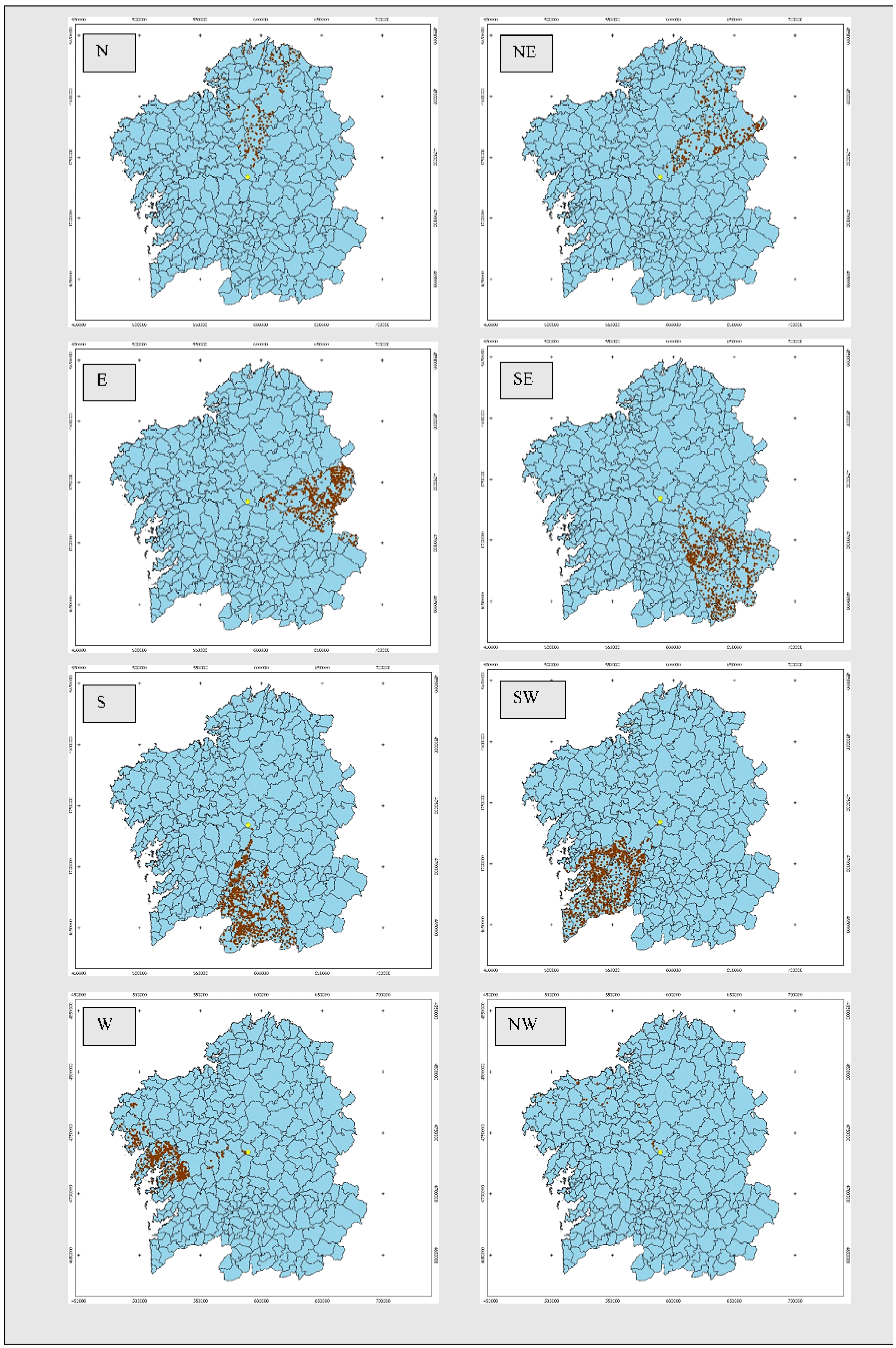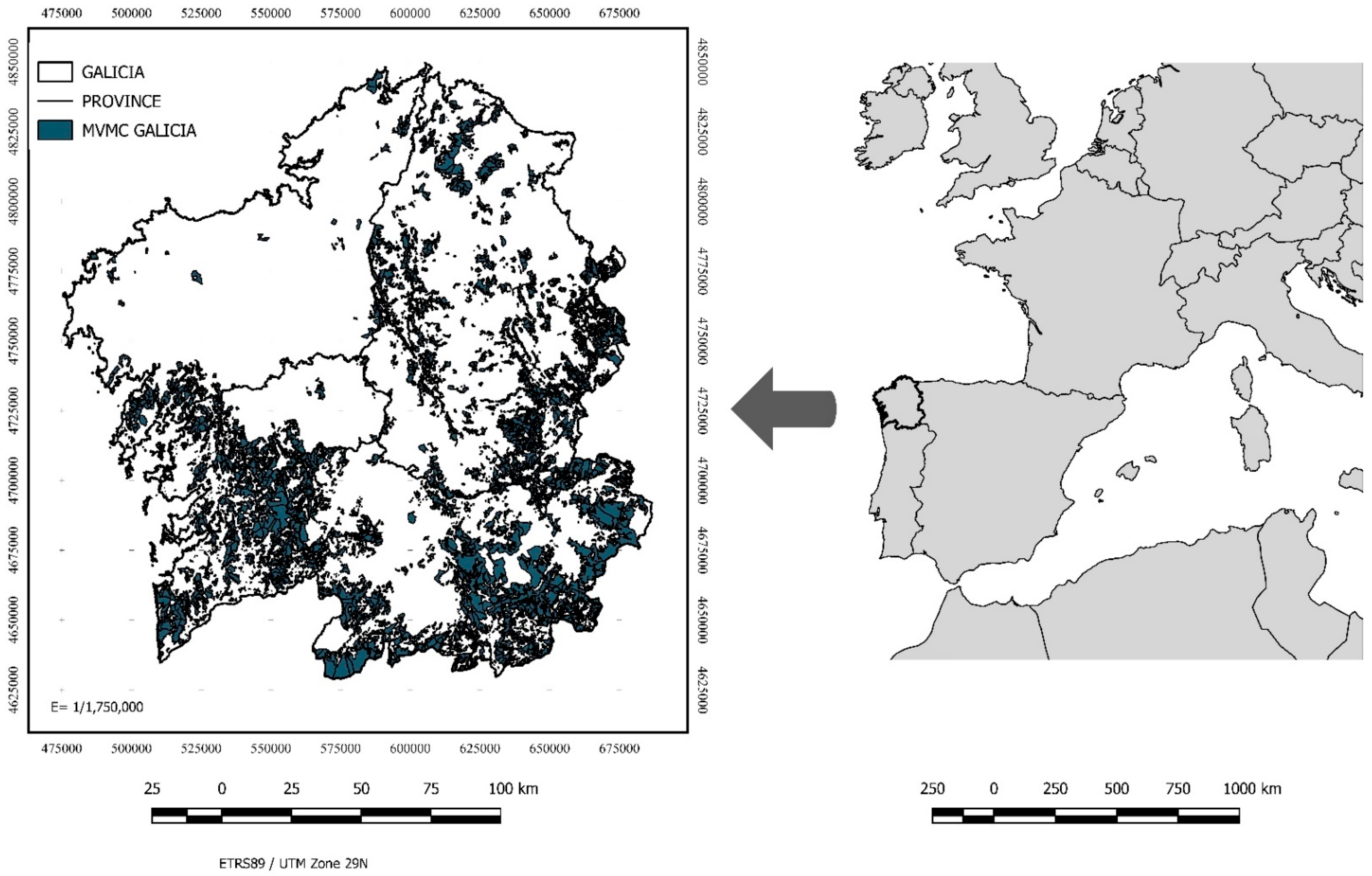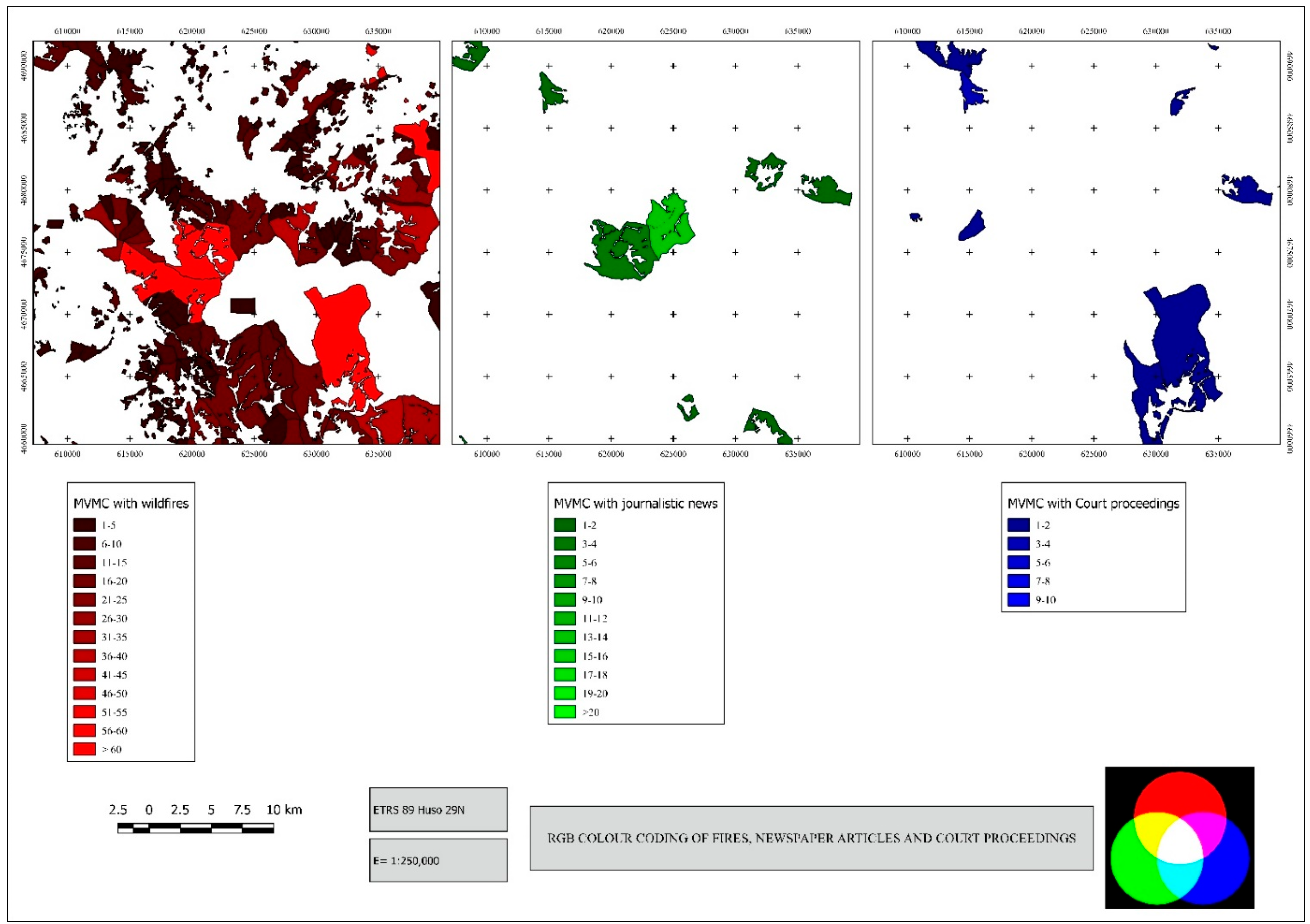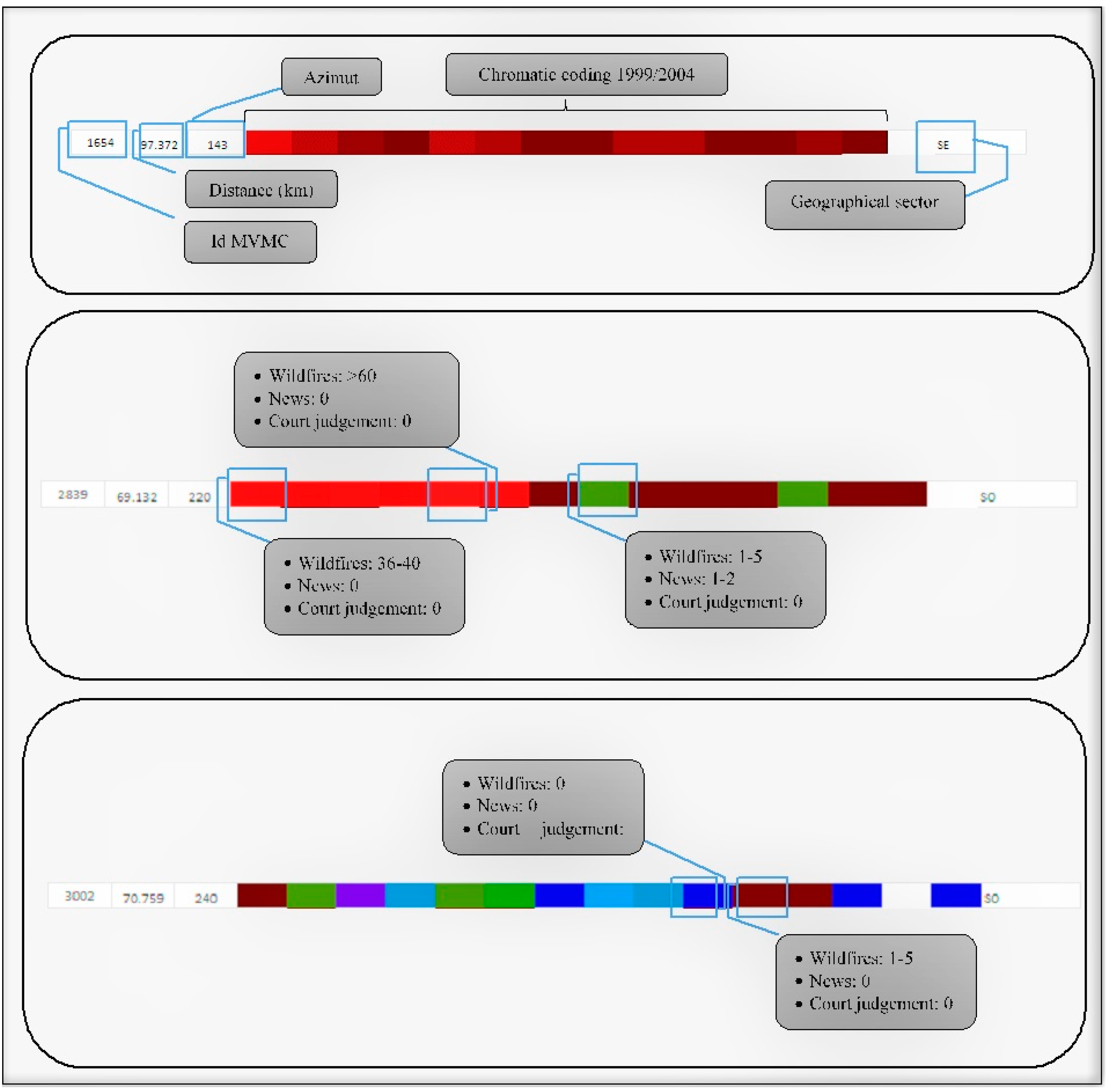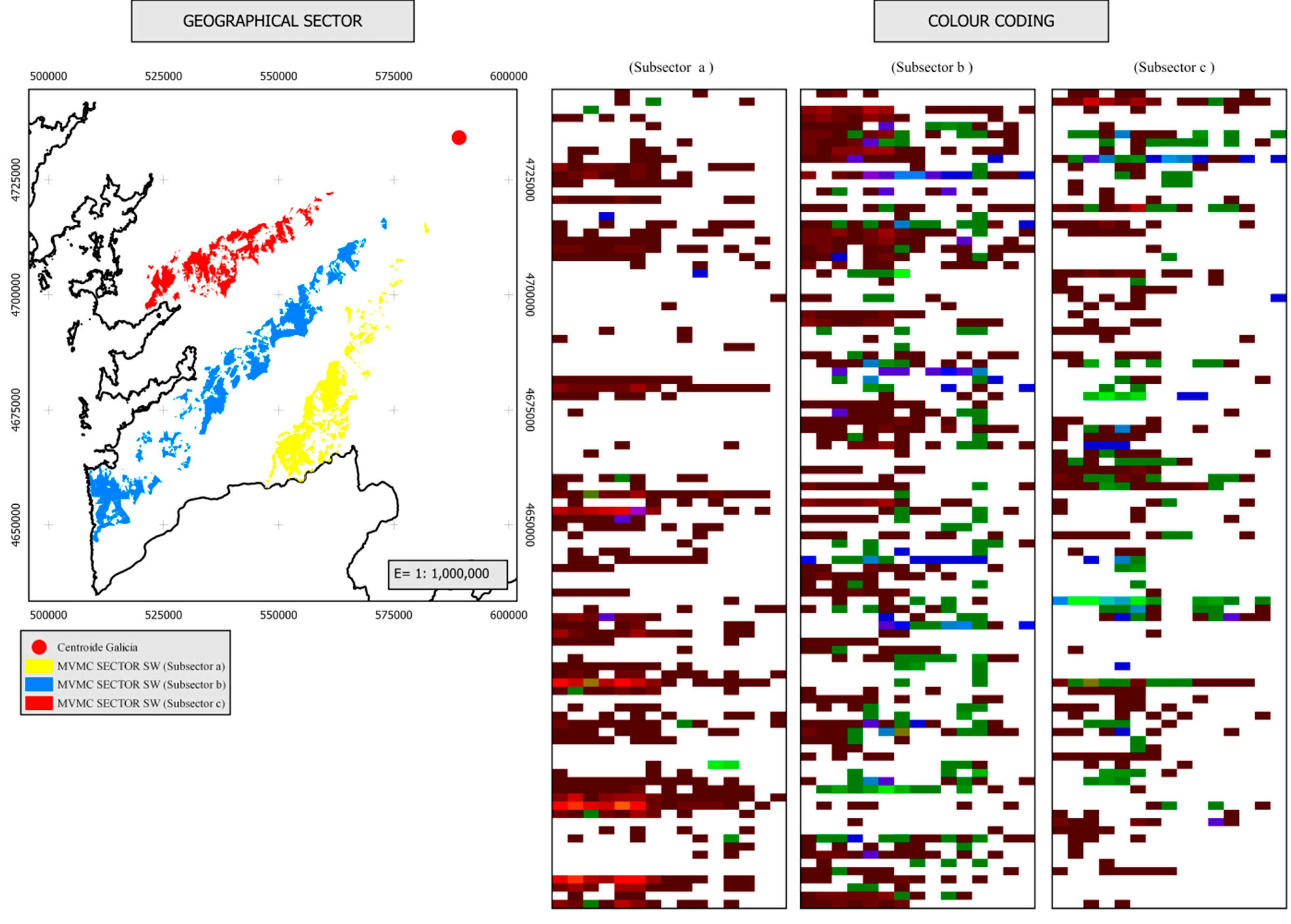1. Introduction
Fire is a fundamental component of most of the Earth’s terrestrial ecosystems [
1,
2,
3] and, although there are others, wildfires are one of the greatest risks to property and people [
4,
5,
6,
7,
8]. Forest fires destroy more than 1.3 million hectares in Europe each year [
9,
10], causing dozens of deaths annually [
11] and in some years hundreds of deaths [
12]. However, their impact is expected to increase in the future [
13,
14], despite great economic efforts that have been made in recent years [
15,
16,
17]. It is also necessary to highlight the fact that forest fires are closely linked to human activity, and are often caused by social conflicts [
18,
19,
20]. Although a recent study claimed that the number of human-caused fires had been overestimated [
21], other authors have pointed out that up to 95% of forest fires were either caused by humans [
22,
23] or related to human activity [
24].
In order to fight forest fires, it is necessary to increase our knowledge of them, as this knowledge allows us to predict the behavior of forest fires [
25]. In the following paragraphs, we briefly explain some of the factors that determine the behavior and spread of wildfires, some of the causes that lead to ignition, and some of the different mathematical models that have been developed to evaluate the roles of these factors.
Among the causes studied are social or socioeconomic factors, whose role is currently much less known than that played by biophysical factors [
26,
27,
28]. It is also necessary to consider that the role of biophysical factors is more relevant for their effect on fire behavior than for their direct effect on fire itself, and that human pressure is one of the most important drivers of a wildfire [
29]. This factor, human pressure, is among the main causes of forest fires as once pointed out by [
19] and in a recent work by [
21] contrasted for a large part of the Mediterranean area. The same aspect has also been verified in other regions of the world. In this sense, a study on forest plantations in Brazil stated that most of the climatic variables, considered in isolation, do not have a strong direct relationship with fire occurrence [
30]. More factors, therefore, need to be analyzed, as detailed information on the causes and motivations of fires is crucial to develop actions aimed at changing social and individual attitudes and behaviors that lead to forest fires [
21,
25].
This intentional nature is due to various factors. Thus, changes in population density [
26,
31], for example, or the abandonment of agricultural work and the consequent use of fire as a tool for clearing and fertilizing plots increase the possibility of fire. In this sense, small-sized land plots can also increase the occurrence of forest fires, as the mechanization of these plots is more expensive and difficult, which may encourage managers to carry out cheaper brush removal methods, such as the removal of the undergrowth with fire [
32]. Depopulation in wildland–urban interface areas can also lead to a higher number of wildfires [
33,
34,
35,
36]. This is especially important as deliberate fires are, together with those caused by lightning and power lines, the fires that affect houses the most [
37,
38,
39]. In addition, high density of machinery increases the likelihood of accidental ignition by sparks [
32]. Additional causes include unemployment as a trigger for forest fires [
39], or the loss of land value [
40], which favors land abandonment and increases the risk of fires. Other authors have also emphasized the density of roads and road networks [
41]; another author, in a now classic paper [
32], found a direct relationship between twelve of the thirteen variables they analyzed and the occurrence of forest fires. Some other causes for which a relationship with fire occurrence was found were poverty [
11,
42], an increase in forest area [
43] and scrubland [
44]; and ineffective forest policies [
45,
46].
The process of collecting data has been made difficult for two reasons. Firstly, there is an enormous amount of information coming from different sources, in various formats, etc. Secondly, in the case of judgments, the legislation on personal data protection has made access to information difficult.
The fact that a wide range of factors are involved in the occurrence of forest fires has led to the development of different statistical methods to assess the role of each of these factors. Different simulation models have been developed. Simulation modeling is an effective and economical way to study the relationships among fire regimes, climatic vegetation, and fire management [
39], which can be used to preassess the potential impact of different fire management techniques. In this regard, many different mathematical models have been developed over time to try to predict the possible occurrence of a forest fire, which have been progressing in a constant study of the multiple factors involved in the phenomenon. However, given that there is no linear relationship between wildfire drivers and the occurrence of wildfires [
12], it is necessary to establish highly flexible nonlinear models to predict the complex processes that occur in reality [
17]. In this constant search for flexibility and accuracy, there has been a shift from generalized linear regression models (GLM) [
47,
48,
49] to generalized linear mixed models (GLMM), which incorporate random effects to linear predictors [
50]. GLM models are an extension of linear models that can handle non-normal distributions of the response variable, providing an alternative way of transforming the response. The distributions used include those such as Poisson, binomial, negative binomial and gamma [
26]. Subsequently, non-linear models emerged such as generalized additive models (GAM), which include smoothing functions associated with the covariates of the linear predictor [
51,
52], or generalized additive mixed models (GAMM), which are an extension of the previous ones. Others authors [
53], in a study on wildfire prediction in Galicia (Spain), have taken a step beyond the classic GLM and GAM and developed structured additive regression (STAR) models, which are much more flexible, as they allow the combined use of spatial and temporal covariates with continuous covariates, which improve the calculation of forest fire risk. Another example is GWR models, a statistical technique used in the exploratory analysis of spatial data and developed in the framework of local or statistical spatial modeling. Local models can be inferred as the spatial disaggregation of global statistics whose main characteristic is the fact that they are calibrated from a spatially limited sample set, and therefore, produce local regression parameter estimates [
54]. Therefore, GWR techniques extend the traditional use of global regression models, allowing the calculation of local regression parameters [
26].
With regard to the variables used as predictors in the different mathematical models, these have also undergone enormous variations. For example, the first studies used only climatic variables, such as precipitation or average temperature [
55,
56,
57]. Later, variables describing physiography, such as slope or exposure, were added [
58]. Variables referring to the existing fuel in a study area were also introduced, such as the moisture content of the dead fine fuel or the type of scrub [
59], which largely determine fire behavior. In any case, the choice of variables depends, to a large extent, on the country under study and the fire casuistry in that country. Thus, in those countries where intentionality is high, socioeconomic variables tend to be included in the models, while in those countries where the occurrence of forest fires is due to random ignition, climate and physiographic variables are included, in addition to those that refer to the existing fuel.
Among the socioeconomic variables most commonly used by researchers we can cite population density [
5,
29,
60,
61]; unemployment [
62,
63]; machinery density [
35,
64]; and livestock density [
65,
66]. The influence of more unusual variables has also been analyzed, such as the relationship between the occurrence of wildfires and the holding of electoral processes in Northwest Spain [
67], or the possible relationship that forest fires may have with the value of land [
68], or with the presence of the Natura 2000 network [
69].
Regarding the role of infrastructure in the occurrence of wildfires, various variables have been analyzed such as the distances of ignition sources to road networks or to the nearest population center [
14,
17,
30,
61]; the density of roads [
70,
71]; or the presence of infrastructure where accidental or negligent ignition is common, such as railways or power lines [
49,
72].
However, social conflict has been poorly discussed in the scientific literature, despite the fact that it is an aspect of great relevance in geographical regions where the percentage of human-caused forest fires is very high. It is, therefore, necessary to develop methods to analyze the role of social conflict in the occurrence of forest fires. In relation to this, to give continuity to what was outlined in two previous papers [
73,
74], in this study, we propose a new methodology for the detection of spatio-temporal patterns of human-caused forest fires. Thus, by means of the proposed chromatic code, which uses variables related to social conflict, it would be possible to detect spatio-temporal patterns that could not be detected by more classical methods, such as clusters. The aim of this paper is to show the methodology developed by integrating spatial and temporal information of the conflict measured by counting journalistic news and/or judicial proceedings in which montes vecinales en mano común (MVMC) has been involved, and then by means of the proposed chromatic coding, a visual way allows us to easily determine the most problematic incendiary areas. We hypothesize that the existence of distinct spatial and temporal trends can be explained by analyzing the evolution of each MVMC separately over time. The fact that MVMCs have been chosen as the working units is due to the importance of this type of land tenure in Galicia, the relevance of which for the forestry sector is described in subsequent paragraphs.
3. Results
Relevant differences were found between geographical sectors in terms of the distribution of wildfires, press reports, and legal proceedings (
Table 4). It was observed, for example, that the highest wildfire rate was in the SW sector (6.92 wildfires/100 ha of MVMC). This ratio was also found to be 3.37 in the SE sector, very similar to that found in the NW sector (3.13), where the area of MVMC was about 43 times lower.
Differences can also be observed in
Table 5, which shows the wildfires, newspaper reports, and sentences produced in the MVMCs of Galicia during the period considered which serves as a basis for obtaining the chromatic code. This table shows that the highest number of wildfires (35.3% of the total) occurred in the SW sector, where 50.66% of the news items and 43.11% of the court rulings also took place. These data seem to indicate, at a first approximation, a certain relationship between these variables, since only 21.62% of the MVMCs are included in this sector. However, this supposed relationship seems to be contradicted in the SE sector, where, with a similar number of MVMC (17.66% of the total), 24.25% of the fires occur, and only 4.38% of the newspaper reports or 10.55% of the sentences. At the opposite end of the spectrum are the NW sectors, where, with 0.82% of MVMCs, 0.52% of fires, 1.90% of news items, and 1.79% of sentences are concentrated; and the N sector, where 5.14% of MVMCs, 3.17% of arson, 3.84% of newspaper reports, and 6.98% of sentences are concentrated.
By applying the proposed color coding to the data in
Table 1, a color or RGB code is obtained for each MVMC (
Figure 4) and year of the historical series.
The number and percentage of white cells that can be seen in each geographical sector of ConForest, whose meaning has already been explained in the Methodology Section, are shown in
Table 6. If we understand the expression of conflict as the sum of the percentages of wildfires, newspaper reports, and sentences in each sector, we can see that those in which this sum is greater tend to show a lower percentage of white cells in their representation.
After applying ConForest_RGB to each of the MVMCs, we obtain the colors shown in
Table 7, where the frequency of each of the resulting colors is also shown.
As a final explanation,
Figure 5 is provided, which shows three examples of the chromatic coding. For a correct interpretation of the results obtained, it is important to observe the chromatic changes that occur in the coding of a specific MVMC over the years, especially if after the occasional appearance of green and blue colors (newspaper reports and court sentences, respectively), more reddish tones appear (wildfires).
The cartographic representation of ConForest_RGB allows us to detect the existing differences between MVMC in terms of social conflict, as shown in
Figure 6, where we have represented several maps to check the evolution of conflict during the study period considered. Due to the scale at which we are forced to represent the map, we prefer to show only a small region of Galicia to facilitate the visibility of the image (in this case a region of the southwest sector).
Figure 7 shows the representation of the ConForest_RGB coding for Galicia, as well as a window showing the area represented in the previous figure. In this case it is the coding corresponding to the year 2005.
Given the large number of rows that make up the chromatic coding of some geographical sectors (in the SW sector, for example, there are 656 MVMCs, so the coding has the same number of rows) it is not possible to include the final result of the chromatic coding in a single representation. Therefore, we have chosen to show only the individual results of two geographical sectors (
Figure 8 and
Figure 9). One additional aspect should also be noted. In the sectors depicted in
Figure 8 and
Figure 9, there are a large number of MVMCs. Therefore, we decided to include in these chromatic codings only 300 MCVMs (45.73% of the existing MVMCs in the southwest sector, and 75.76% of the existing MVMCs in the West sector), divided into three columns of 100 MVMCs each. The first column includes the 100 MVMCs that occupy the first positions in the geographical sector, according to their azimuth. The second column corresponds to the central part of the geographical sector, and the third column includes the last 100 MVMCs of the geographical sector.
4. Discussion
First of all, it must be recognized that the data sources, mainly journalistic reports, may be affected by a significant bias due to the heterogeneity of the study area and, above all, to the demographic differences between coastal and interior areas. In the interior areas, for example (east and southeast geographical sectors, basically), which are much more rural, there is a much lower population density than in the west and southwest sectors. Consequently, the management of MVMCs will also have different objectives, as the negative growth of population density favors short-term approaches, mainly because the economic performance of the MVMC increases substantially in aging communities [
18,
92]. Moreover, in these geographic sectors with lower population density, it is logical that a smaller number of journalistic news items are produced. This is due, fundamentally, to three aspects: the existence of a smaller number of digital newspapers due to the small population and their level of aging; the limited attention paid by the population in these areas to digital media and the written press; and the limited interest of readers in general in forest communities. However, in areas such as the east and southwest sectors, where there is greater economic activity, higher population density and more urban development, it is logical that there are many more news items and even that CMVMCs are involved in legal proceedings concerning surface rights issues.
We know that the occurrence of forest fires can be related to the occurrence of social conflicts [
5,
10,
11,
19,
21,
34,
62]. We also know that conflicts over land ownership and management are the cause of numerous forest fires [
18,
20,
25,
31,
92,
93]. In addition, we also know that an adequate analysis of human-induced forest fires requires a detailed study of social conflict [
68]. Consequently, it seems almost obligatory that the predictive models we use in the investigation of human-induced forest fires include, among their predictor variables, those that express this social conflict. Otherwise, we will not know how to interpret reality and it will be impossible to combat the problem. Aware of this, in the preparation of our article, we used newspaper reports and legal proceedings that referred to boundary disputes, assembly disagreements, surface rights, or actions denying easements, for example, because all these reasons can give rise to social conflicts and cause, as a response, numerous forest fires.
Our research team has participated in different proposals related to the prediction and explanation of wildfires [
3,
24,
50,
94], in which advanced statistical methodologies have been developed and applied. Experience tells us that there are two important problems, the first of which is the difficulty of integrating those variables related to qualitative aspects related to the conflict. The second is that the visualization and interpretation of the results requires a high level of knowledge of the statistical methodologies applied. That is why we propose this new methodology ConForest_RGB, which we believe contributes to improve these two aspects.
As shown in
Figure 6 and
Figure 7, ConForest_RGB can also be used in a GIS, in order to check on a map the chromatic variations over the years, which in a way facilitates the visualization of the proposed methodology.
As has been shown, ConForest_RGB allows a visual understanding of the spatial and temporal components of human-induced forest fires. In this aspect, ConForest_RGB satisfies the need for a good knowledge of the spatio-temporal distribution of forest fires, which is crucial for the design of prevention policies adapted to each region [
8,
95]. This method also allows us to visually understand the social conflict that may have been at the origin of these forest fires, thus, allowing us to understand what type of conflicts are more common in each area. If we understand, for example, that in a certain sector there are more conflicts with public administrations, this helps us to implement specific measures. This can be observed, for example, in the SO and O sectors (
Figure 6 and
Figure 7), where MVMCs often have numerous legal proceedings due to urban planning issues or with resource exploitation companies.
The proposed model arose as an evolution and consequence of the 15-year experience of the research group to explain, model, and predict forest fires in the Mediterranean area, especially in the region of Galicia, and focused on arson. Different methodologies have been developed and published, some of which are referenced in this paper. Most of these methodologies are based on advanced statistical techniques, which imply that the reader and the forest manager must have significant knowledge of the applied techniques, which implies a difficulty for their transfer and management by forest and territorial managers. However, the experience acquired over the years, during which we have studied forest fires in depth and participated in decision-making in this field, allows us to affirm that ConForest_RGB can facilitate the understanding of this problem and the decision-making of forest managers.
The methodology presented in this work is novel and, in addition, we consider it to be applicable and transferable due to its simplicity in application and interpretation in a quick and visual way, in the same line in which modern statistical methods are advancing. We believe that it can be applied in all regions where wildfires occur as a result of human activity (conflict) that can be associated with a point in the territory (lawsuits, news about conflicts, burnings derived from agricultural activity, etc.), regardless of the type of property where they are applied.
5. Conclusions
The ConForest_RGB methodology is novel and can help in the explanation of forest fires caused by conflict problems. Social conflict can be measured with metrics such as the number of court sentences and press news reports that act as leading or simultaneous indicators of arson fires.
The main advantage of ConForest_RGB is that it is easy to understand. It is basically a visual method, which does not require the application of complex statistical operations to obtain results. It also allows for the detection of differences between the geographical sectors considered, which helps in the implementation of specific prevention policies for each geographical sector. The figures in Appendix A clearly show the differences between geographical sectors.
ConForest_RGB does not demonstrate the existence of a statistical relationship between forest fires, newspaper reports, and court sentences. However, it allows for the detection of differences between geographical sectors and red hots, which is a first step towards the development of a predictive system for the occurrence of forest fires based on the existence of social conflicts.
Despite the above advantages, there are some things that need to be improved in ConForest_RGB. One of these is the categorization of the conflict. In a dispute, the response would depend, to a large extent, on its type of identity, for example, in a land rights dispute the response would be different if a public administration or a commoner who has been excluded from the CMVMC. It is also necessary to assess the bias alluded to above, when mentioning the demographic differences between coastal and inland areas. Moreover, is not easy to examine newspaper archives over a long period of time, it would be necessary to analyze which variables we could use as an expression of social conflict in order to introduce them into ConForest_RGB.
Future works should be oriented to verify the existence of a statistical relationship among forest fires, newspaper reports, and judicial sentences. This would allow the development of a version of ConForest_RGB with predictive capacity.
